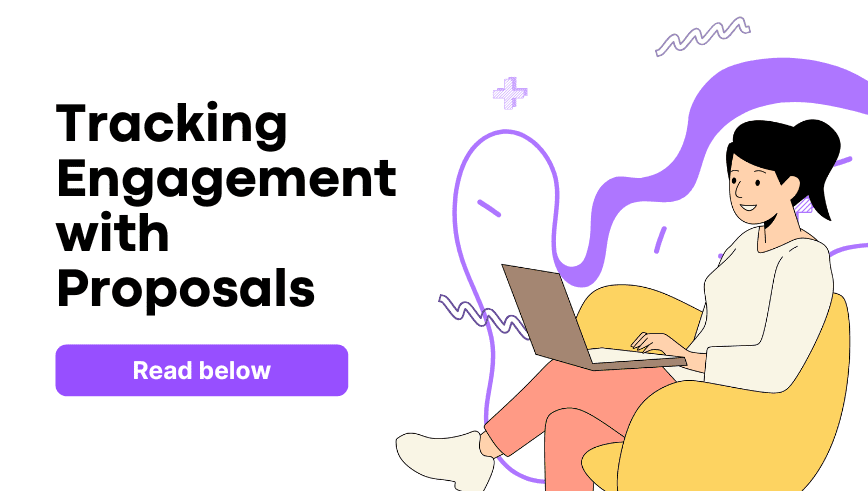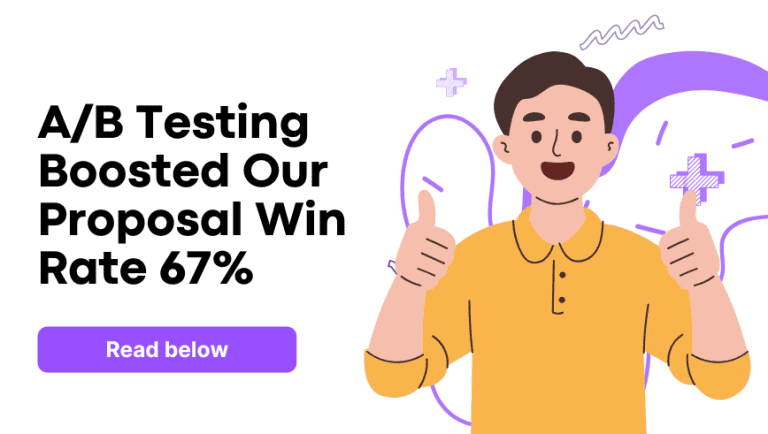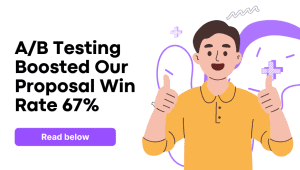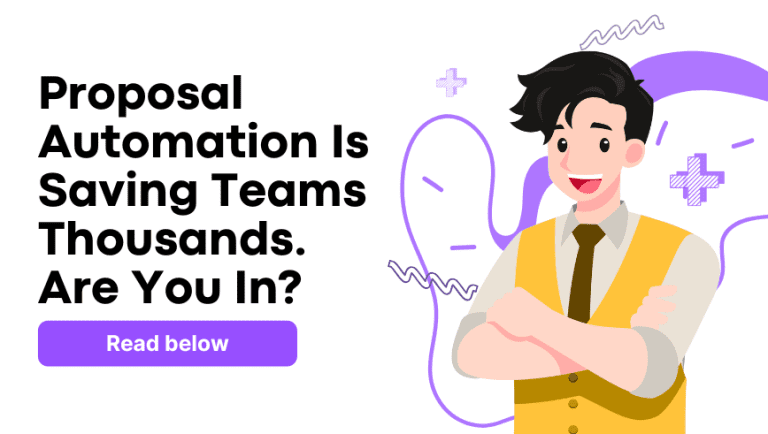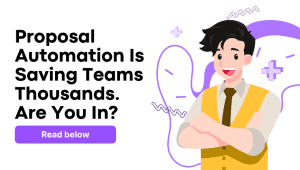إذا سبق لك أن أرسلت عرض مبيعات ثم انتظرت... وانتظرت أكثر، فأنت تعلم سبب وجود هذه المدونة. الخبر السار هو أن التفاعل مع العروض ليس أمرًا غامضًا، بل يمكن تتبعه وفهمه والتصرف بناءً عليه. وعند تطبيقه بشكل صحيح، يُسهم في تحسين معدلات إتمام الصفقات بطريقة أقرب إلى استراتيجية فعّالة لا إلى لعبة تخمين.
دعونا نستعرض كيفية تتبع تفاعل العملاء مع العروض، وما هي مقاييس تفاعل العملاء المهمة، وكيف يمكن لهذه الرؤى أن تساعدك على إتمام الصفقات بشكل أسرع. هذه ليست مجرد أفكار رفيعة المستوى؛ بل هي مبنية على التحديات التي شهدناها شخصيًا أثناء العمل مع شركات مختلفة.
التحول: لماذا يُعد تتبع مشاركة المقترحات أمرًا مهمًا الآن
في بيئة الأعمال بين الشركات (B2B) اليوم، لم يعد إرسال عرض سعر هو نهاية المطاف، بل هو نقطة المنتصف. إذا كنت لا تزال تعتمد على رسالة بريد إلكتروني متابعة بعد ثلاثة أيام تسألك "فقط للاطمئنان"، فهناك طريقة أفضل.
يتصرف المشترون اليوم بشكل مختلف. فهم يقارنون ويبحثون ويؤجلون اتخاذ القرارات. وبدون معرفة كيفية تفاعلهم مع عروضك، فأنت في الواقع تسير في اتجاه أعمى. لهذا السبب، يصبح تتبع تفاعلهم مع العروض خطوة عملية وضرورية للفرق التي ترغب في اتخاذ موقف استباقي بدلًا من رد الفعل.
لفهم مواطن ضعف اهتمام العملاء المحتملين أو تعثرهم، تحتاج إلى متابعة دقيقة. وهنا تبرز أهمية تتبع تفاعل العملاء مع العروض. باتباع النهج الصحيح، تتعلم الشركات تحديد توقيت عمليات المتابعة بشكل أفضل، وتحسين رسائلها، وكشف العوائق في عملية تقديم العروض. تخيل أنك قادر على توقع احتمالية إتمام صفقة بمجرد متابعة أداء العرض آنيًا: هذه هي قيمة تتبع التفاعل.
ومع إنفاق مشتري B2B أكثر من 27% من وقتهم إن إجراء بحث مستقل والحصول على رؤى حول نشاطهم فيما يتعلق بمقترحك هو إحدى نقاط الاتصال القليلة التي يمكنك التحكم فيها.
ما الذي يجب عليك تتبعه داخل الاقتراح
ليست كل المقاييس مفيدة. المهم هو معرفة كيفية تتبع مشاركة المقترحات وأي الإشارات تُترجم إلى نية المشتري. إليك النقاط الأساسية مقاييس مشاركة الاقتراح أن معظم الشركات تستفيد من:
- أسعار الفتح يُخبرك ما إذا كان عرضك قد تم الاطلاع عليه. إذا كان هذا العدد منخفضًا، فقد ترغب في إعادة النظر في عناوين بريدك الإلكتروني أو توقيت التواصل. على سبيل المثال، قد تحتاج الشركات التي لديها عملاء دوليون أكثر إلى مراعاة المناطق الزمنية عند جدولة الإرسال. يتراوح متوسط معدلات فتح العروض في هذا المجال حول 60%، ولكن فرق المبيعات عالية الأداء غالبًا ما... يتجاوز 80%.
- الوقت المستغرق في الصفحة هل يقضي عميل محتمل خمس دقائق في قسم التسعير لديك؟ هذه إشارة. هل يقضي ٢٠ ثانية فقط إجمالاً؟ هذه إشارة أيضًا. النقطة الأهم هنا هي فهم النية. هل يدرسون نطاقك أم يتخطونه تمامًا؟
- عدد المشاهدات قد يعني تعدد المشاهدات من عنوان IP نفسه أن عرضك يُشارك داخليًا. وهذه علامة جيدة في مبيعات الأعمال التجارية بين الشركات (B2B). إذا تم الوصول إلى العرض نفسه عبر أجهزة متعددة، فمن المرجح أنه يتقدم في سلسلة اتخاذ القرار. كلما تمت مراجعة العرض أكثر، زادت نيته. لقد شهدنا شركات تُبرم صفقات حيث تم فتح العروض من 6 إلى 10 مرات خلال أسبوع واحد.
- المشاركة على مستوى القسم معرفة الأجزاء التي تمت قراءتها أو دراستها تُحسّن الإصدارات المستقبلية. إذا انقطع الجميع عن قراءة عرض القيمة الخاص بك قبل عرضه، فهناك خطأ ما. حتى أن بعض الشركات تُعيد تصميم نماذج عروضها بناءً على هذه البيانات للحفاظ على اهتمام القراء. يُساعد تتبع الوقت المُستغرق في الأقسام على تحديد أولويات ما يُقدّره عميلك المُحتمل أكثر.
- تنزيل الأحداث ومشاركتها إذا تم تنزيل أو مشاركة مقترحك، فهذا يعني عادةً أن صانعي القرار متورطون. غالبًا ما تتفاقم الصفقات أو تتعثر، وهذه المعرفة ضرورية لاستراتيجيات متابعة المقترح. قد يشير تنزيل المقترحات، متبوعًا بعدم النشاط، إلى تأخير في الموافقة الداخلية.
- النقرات على الروابط المضمنة أو دعوات العمل إذا أضفتَ دراسات حالة أو عروض فيديو توضيحية أو تقويمات، فإن النقرات هنا تُعدّ بمثابة تحويلات صغيرة. فهي تُشير إلى اهتمام أعمق وتُتيح لك فرصةً للتفاعل مع جمهور أكثر تخصيصًا. استخدمها كمحفزات للمتابعة.
هذه ليست مقاييس زائفة، بل هي أساس تتبع أداء الاقتراح، مما يمنحك نظرةً فوريةً على وضع كل صفقة. مع بياناتٍ كافية، ستبدأ برؤية أنماطٍ تُساعد على تحسين كلٍّ من الرسائل والتوقيت. كلما تتبعتَ تفاعلَ العروض، أصبح مسار مبيعاتك أكثر ذكاءً.
أعمال مختلفة، احتياجات مختلفة
ستنظر شركة ناشئة في مجال البرمجيات كخدمة (SaaS) تُبرم صفقات متوسطة الحجم إلى بيانات العروض بشكل مختلف تمامًا عن شركة استشارية تستجيب لطلبات عروض حكومية. ولذلك، لا يبدو تتبع تفاعل العروض متماثلًا عبر مختلف القطاعات وأحجام الشركات.
- الشركات الناشئةقد يستخدمون بيانات التفاعل لتحسين مستويات التسعير أو نماذج عروض اختبار A/B. بالنسبة لهم، حتى التحسينات البسيطة في التفاعل قد تؤدي إلى قفزات كبيرة في التحويل. معرفة أين يقضي العملاء المحتملون وقتهم تساعد في تحسين رسائل المنتج.
- الوكالات ومقدمي الخدمات:يمكن تحديد سبب تحويل بعض العملاء بشكل أسرع من غيرهم. غالبًا ما يستخدمون مقاييس لتحديد صفحات الخدمة التي تُحسّن من عملية انضمام العملاء. يُساعد تتبع تفاعل العملاء مع العروض في صياغة حلول أكثر تخصيصًا.
- الشركات: نحتاج إلى تحليلات مفصلة عبر الأقسام وأصحاب المصلحة المتعددين، وغالبًا ما نعمل مع دورات مبيعات أطول وأكثر تعقيدًا. يمكن للتفاعل هنا أن يُبرز المعوقات الداخلية أو عدم توافق الأقسام. كما يُساعد في ربط فرق المشتريات أو الشؤون القانونية بالسياق المناسب.
في الواقع، بالنسبة لمبيعات الشركات، يُعدّ تتبّع من فتح العرض، ومتى، وعدد مرات فتحه، بنفس أهمية المحتوى نفسه. يمكنك قراءة المزيد عن رؤى المبيعات طويلة الدورة. هنا.
بعض القطاعات، مثل الرعاية الصحية والقانون والتكنولوجيا المالية، لديها أيضًا متطلبات امتثال تؤثر على كيفية مشاركة المقترحات أو مراجعتها. يضمن تتبع التفاعل الشفافية ويسمح للفرق بتوثيق الأنشطة لإعداد التقارير الداخلية. يصبح هذا أمرًا بالغ الأهمية عندما يحتاج المدققون أو الفرق القانونية إلى سجل رقمي لاتصالات العملاء.
تعتمد طريقة تتبع تفاعل العروض أيضًا على مدى التعاون أو التنافس في قطاعك. في بيئات المناقصات عالية المخاطر، حتى معرفة المدة التي راجع فيها أحد المنافسين المواد التي شاركتها قد تمنحك ميزة استراتيجية.
تحويل المقاييس إلى إجراءات: المتابعة التي تبدو في الوقت المناسب
البيانات مفيدة فقط عندما تساعدك على اتخاذ القرار. بعد تثبيت برنامج تتبع العروض، إليك بعض النصائح: استراتيجيات متابعة المقترحات يمكنك تجربة:
- مشاركة عالية؟ أرسل تنبيهًا في الوقت المناسب. إذا راجع أحدهم عرضك ثلاث مرات اليوم، فهذا يُعَدُّ فرصةً مُغريةً. احجز مكالمةً، وليس بريدًا إلكترونيًا تذكيريًا. حتى أن بعض الفرق تُؤتمت روابط التقويم في عمليات المتابعة بناءً على هذا السلوك. تُحسِّن المتابعة الشخصية خلال 24 ساعة من ذروة التفاعل معدلات الاستجابة من خلال: حتى 60%.
- مشاركة منخفضة؟ راجع قسمي المقدمة والقيمة. إذا توقف معظم العملاء المحتملين عن القراءة مبكرًا، فقد تحتاج إلى إضافة جذابة. جرّب مقاطع فيديو تعريفية أو لقطات نجاح العملاء.
- إعادة توجيه صانع القرار؟ تواصل مع الآخرين بمحتوى مُخصّص. إذا لاحظتَ وصول عميل جديد إلى العرض، فهذا وقت مناسب لمشاركة قصة نجاح العميل أو الأسئلة الشائعة. هذا يُساعد مجموعات الشراء متعددة الأطراف على التقدم بشكل أسرع. في المتوسط، تتمتع عروض الأعمال بين الشركات التي يصل إليها أكثر من 3 جهات معنية بـ 70% فرصة أعلى من التحويل.
يمكنك قراءة المزيد حول كيفية تقليل التأخير في الصفقات هنا.
كيف يبدو التتبع الجيد في الواقع
التتبع الجيد لا يعني إغراق بريدك الإلكتروني بالتنبيهات، بل يتعلق بلوحة معلومات واحدة تعرض المعلومات الصحيحة، في سياقها، عند الحاجة. تصميم جيد برنامج تتبع المقترحات سوف:
- عرض جدول زمني لجميع الأنشطة
- تسليط الضوء على العملاء المحتملين بناءً على السلوك الحقيقي
- تتيح لك تعيين تذكيرات ذكية استنادًا إلى المشاهدات وعدم النشاط
- التكامل مع نظام إدارة علاقات العملاء الخاص بك حتى لا يضيع أي شيء
لا يقتصر الأمر على مراقبة ارتفاع الأرقام فحسب، بل يتعلق أيضًا باستخدام هذه الرؤية لجعل كل خطوة من خطوات عملية تقديم عرضك أكثر ذكاءً. على سبيل المثال، إذا كنت تعلم أن معظم الصفقات تتباطأ بعد صفحة التسعير، فقد يكون الوقت قد حان لاختبار تصميمات تسعير تُولي القيمة الأولوية.
إذا كنت تتعامل مع طلبات عروض الأسعار، يصبح الجدول الزمني بالغ الأهمية. يعتمد العديد من الموردين على السرعة. للحصول على نصائح حول سرعة الاستجابة لطلبات العروض، يُرجى الاطلاع على هذا الرابط: كيفية الاستجابة بشكل أسرع.
أفضل برامج تتبع المقترحات تُحوّل هذا إلى نظام مُحسّن ذاتيًا. كل مقترح جديد يُبنى على الدروس المستفادة من المقترح السابق.
الفائدة الخفية: تأهيل العملاء المحتملين بشكل أفضل
واحدة من الأشياء التي تم التقليل من شأنها فوائد تتبع مشاركة المقترحات هذه هي الطريقة التي تساعدك بها على تحديد العملاء المحتملين بدقة أكبر. إذا أمضى أحدهم خمس دقائق في التعمق في نطاقك وشروطك، فهو جاد. أما إذا فتح عرضك مرة واحدة ولم يعد، فمن المرجح أنه لم يكن جادًا.
هذا ليس رفضًا، بل وضوح. وهو ما يساعدك على الانتقال بسرعة أكبر إلى الفرصة التالية أو العودة برؤية أوضح. إذا كنت تواجه هذا السيناريو، هذا الدليل قد يكون مفيدًا.
مع مرور الوقت، يُنشئ هذا النهج حلقة تغذية راجعة. تُصبح مقترحاتك أكثر تماسكًا، ويُصبح عرضك أقوى، وتبدأ بتوقع الاعتراضات ومعالجتها حتى قبل ظهورها.
غالبًا ما تظهر مؤشرات مبكرة على العملاء المحتملين ذوي الجودة العالية من خلال تفاعلهم مع محتواك. يساعد تتبع تفاعل العملاء المحتملين على التمييز بين الإشارات والتشويش، مما يزيد من كفاءة مسار مبيعاتك.
جعل مشاركة المقترحات مقياسًا للفريق
المبيعات لا تقتصر على إتمام الصفقات، بل على التعلم. عندما تُعامل بيانات التفاعل كحوار جماعي، يُمكن للتسويق أن يُنتج موادًا ترويجية أفضل، ويُمكن للمبيعات أن تُحسّن عروضها، ويُمكن إشراك فرق نجاح العملاء في وقت أبكر.
يمكنك أيضًا تعيين طقوس الفريق حولها:
- مراجعة أسبوعية للمقترحات الأكثر تفاعلاً
- مشاركة التعليقات حول الأماكن التي يتوقف فيها القراء
- تبادل الأفكار لإيجاد عناوين أفضل للمقترحات ذات الأداء الضعيف
إن متابعة تفاعل العملاء مع العروض ليست مهمة شخص واحد، بل هي تحول في طريقة التفكير، تحول يُحوّل فريق المبيعات لديك من متفاعل إلى ثاقب، ومن متفائل إلى مُلِمٍّ.
عندما تتعاون الفرق حول مقاييس مشتركة، تصبح عملية تقديم العروض تجربة مشتركة (وليس مجرد مهمة مبيعات). وهذا مفيد بشكل خاص للشركات التي تعتمد على التسويق القائم على الحسابات أو رحلات الشراء الأطول بين الشركات.
عند التنفيذ الصحيح، يُصبح تتبع تفاعل المشاركين في المقترحات بمثابة الرابط بين الفرق، فهو يُعزز المساءلة ويُحسّن استراتيجية المقترحات العامة.
كيف تُشكل رؤى مشاركة المقترحات دليل المبيعات الخاص بك
إن تتبع تفاعل المقترحات لا يُحسّن فقط من طريقة متابعتها، بل يُغيّر أيضًا أسلوب العمل. عندما تدرس الفرق بنشاط مقاييس مشاركة الاقتراحيكتشفون أنماطًا في سلوك المشتري تؤثر على ما يُرسل ومتى. على سبيل المثال، إذا كان العملاء المحتملون ذوو النية القوية يزورون صفحة التسعير ثلاث مرات قبل إتمام الصفقة، فيمكن لفريقك جدولة مكالمة استباقية بعد الزيارة الثانية.
إذا كانت فرص نجاح العملاء المحتملين في منتصف مسار المبيعات تتوقف غالبًا بعد مراجعة الجدول الزمني للمشروع، فقد يكون الوقت مناسبًا لإضافة اقتباس أو شهادة عميل إلى هذا القسم. هذا النوع من الرؤى الفورية يُحسّن طريقة تعامل فريق المبيعات مع الاعتراضات ويُبرز القيمة.
ليس عليك مراجعة كل شيء دفعةً واحدة. ابدأ بإجراء تعديلات طفيفة بناءً على لوحة معلومات تتبع أداء مقترحك، ودع ذلك يُشكل استراتيجيتك المستقبلية.
استخدام بيانات مشاركة المقترحات لتدريب فرق المبيعات
بيانات تفاعل العروض تُعدّ كنزًا ثمينًا للتدريب. يستطيع قادة المبيعات مراجعة العروض الناجحة والضعيفة لتحديد ما نجح وما لم ينجح. إذا واصل أصحاب الأداء المتميز كتابة عروض افتتاحية أقوى أو حصلوا على نسب نقر أعلى على دعوات العمل، فيجب مشاركة هذه المعلومات مع جميع أعضاء الفريق.
يمكن للموظفين الجدد الانضمام إلى فريقك بأمثلة على عروض عمل تفاعلية، مما يُمكّنهم من التعرّف بشكل أسرع على المحتوى الذي يلقى صدى لدى جمهورك المستهدف. يُساعد دمج التدريب مع البيانات الفعلية على تعزيز الدروس المستفادة وبناء ثقافة مبيعات متينة تتطور مع مرور الوقت. إذا تابعتَ تفاعل الجمهور مع العروض بانتظام، فستُحدَّث موادك التدريبية تلقائيًا.
مستقبل تتبع مشاركة المقترحات: الذكاء الاصطناعي والخصوصية والأخلاقيات
مع تطور برامج تتبع العروض، تتطور أيضًا المسائل الأخلاقية. ورغم قوة بيانات التفاعل الآنية، إلا أن الشركات بحاجة أيضًا إلى مراعاة لوائح الخصوصية وراحة المشتري. مستقبل... كيفية تتبع مشاركة المقترحات يتضمن خرائط حرارية مجهولة المصدر، وتسجيل نقاط مدعومة بالذكاء الاصطناعي، واقتراحات تنبؤية لأفضل إجراء تالي.
على سبيل المثال، قد تقترح أدوات التنبؤ بالتفاعل قريبًا أوقات إرسال مثالية بناءً على السلوك السابق. ولكن مع تطور هذا الوضع، ستكتسب الشفافية والثقة في كيفية استخدام البيانات أهميةً تعادل أهمية البيانات نفسها. إن فهم هذه التغييرات يضمن لك الالتزام باللوائح مع تحسين معدلات إتمام المعاملات.
إجابات سريعة: الأسئلة الشائعة حول كيفية تتبع مشاركة المقترحات
ما هي أفضل الطرق لتحسين معدلات إغلاق عروض المبيعات؟
يبدأ تحسين معدلات إتمام الصفقات بمعرفة ما يحدث بعد الإرسال. من أفضل الطرق لتحسين معدلات إتمام صفقات عروض المبيعات تحسين عمليات المتابعة بناءً على مقاييس تفاعل العروض الفورية، وتقصير مدة العروض لجذب الانتباه، وإرسالها في أوقات ذروة التفاعل. بتتبع تفاعل العروض باستمرار، ستحصل على التوقيت والسياق اللازمين لتحسين نتائج كل صفقة.
ما هو معدل المشاركة في الاقتراح الجيد؟
يختلف الأمر باختلاف القطاع، ولكن إذا تم فتح أكثر من 60% من عروضك والاطلاع عليها لأكثر من دقيقتين، فأنت على الطريق الصحيح. تُحقق الشركات التي تستخدم برامج تتبع العروض تفاعلاً أعلى، خاصةً عندما تتبع استراتيجيات متابعة العروض التي تتوافق مع سلوك المشتري.
ما هي فوائد تتبع مشاركة المقترحات للشركات الصغيرة؟
تتجاوز فوائد تتبع تفاعل العملاء مع العروض البيانات فحسب. إذ يُمكن للشركات الصغيرة تحديد العملاء المحتملين ذوي النوايا الحسنة بشكل أسرع، وتصميم عروضها بشكل شخصي أكثر، وتوفير الوقت على العملاء المحتملين غير المهتمين. حتى التغييرات البسيطة القائمة على تتبع أداء العروض يمكن أن تُؤدي إلى نمو ملموس.
كيف يمكنني أن أعرف إذا كان العميل المحتمل مهتمًا بعد مشاهدة الاقتراح؟
تتبع مؤشرات التفاعل مع العروض، مثل المشاهدات المتعددة، أو قضاء وقت طويل، أو النقر على الروابط المضمّنة. تُظهر هذه المؤشرات نية المشتري، ويمكن أن تساعد في تحديد أولويات المتابعة. إذا كانت هذه المؤشرات منخفضة، فقد يكون الوقت قد حان لمراجعة محتواك أو عرضك.
للختام
العروض ليست ملفات PDF تتلاشى في الفراغ، بل هي فرص نابضة بالحياة لمعرفة ما يهتم به عملاؤك حقًا.
عندما تعرف كيفية متابعة تفاعل العملاء مع عروضكم بشكل صحيح، ستتوقف عن الملاحقة وتبدأ بالتوجيه. ستكتب عروضًا أفضل، وتحدد مواعيد متابعاتك بدقة أكبر، وتُبرم الصفقات بشكل أسرع.
في اقتراح.بيزنعمل على تطوير أداة لتسهيل هذا الأمر عليك، أداة فعّالة سواءً كنت شركة ناشئة أو وكالة أو مؤسسة. لا تزال الأداة قيد التطوير، ولكن إذا كنت تتطلع إلى الريادة والانضمام إلى المستخدمين الأوائل، يسعدنا التواصل معك.
دع مقترحاتك تعمل بجهدك. لنبدأ بتتبع أكثر ذكاءً.
